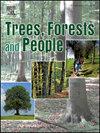Adaptation in ethnobotanical knowledge of Prunus cerasoides among different ethnic groups, religions and culture in Nepal
IF 2.7
Q1 FORESTRY
引用次数: 0
Abstract
Societies, ecosystems and species, including medicinal plants worldwide, are increasingly impacted by the changing context of ecology, land use, socio-economy and climate. All these groups have been adapting to these adversaries. However, conventional adaptation strategies to these changes may not always be effective at helping people or ecosystems to reduce their vulnerabilities. We conducted this study to understand and bolster the ethnobotanical adaptation knowledge regarding using Prunus cerasoides in the trajectory of socio-cultural changes in Nepal. We surveyed 713 participants from eastern, central, and western Nepal to collect primary data. We calculated the species use fidelity level (%) to understand the commonly used plant reports. The Jaccard similarity index was used to investigate the cross-cultural use of P. cerasoides among different sample groups. The Kruskal Wallis test was employed to test the difference in knowledge levels within religion and ethnicity. Out of recorded 11 different use categories of P. cerasoides, eight categories had significant fidelity levels, which include cooking/heating (87.94 %), house construction (86.40 %), livestock feed (84.57 %), culture (79.38 %), food (44.32 %), medicine (26.37 %), apiculture (22.72 %), and agriculture (5.05 %). The species’ uses shared by various religious and ethnic groups differed significantly. In the religious group, Hindus used the species more consistently (median=5 and interquartile range (IQR)=1); likewise, among the ethnicities, Chettri and Thakuri used species more consistently than other ethnic groups (median = 5 and interquartile range (IQR)=1). Among the religious groups, there is a significant difference in fidelity level of culture, livestock feed, food, cooking /heating energy, apiculture, and others. However, in changing contexts, P. cerasoides faces increasing conservation challenges as socioeconomic transformations, deculturation and abandonment of agricultural lands and traditional practices have become prevalent in recent decades.
尼泊尔不同民族、宗教和文化对樱桃民族植物学知识的适应
社会、生态系统和物种,包括世界各地的药用植物,越来越多地受到生态、土地利用、社会经济和气候变化背景的影响。所有这些组织都在适应这些对手。然而,针对这些变化的传统适应战略可能并不总是有效地帮助人类或生态系统减少其脆弱性。我们进行了这项研究,以了解和加强关于在尼泊尔社会文化变化轨迹中使用樱桃树的民族植物学适应知识。我们调查了来自尼泊尔东部、中部和西部的713名参与者来收集原始数据。我们计算了物种使用保真度(%)来理解常用的植物报告。采用Jaccard相似指数对不同类群间的跨文化使用情况进行了研究。采用Kruskal - Wallis测试来测试宗教和种族间知识水平的差异。在记录的11个不同使用类别中,8个类别的保真度显著,分别为烹饪/取暖(87.94%)、房屋建筑(86.40%)、牲畜饲料(84.57%)、养殖(79.38%)、食品(44.32%)、医药(26.37%)、养蜂业(22.72%)和农业(5.05%)。不同宗教和种族群体共享的物种使用差异很大。在宗教群体中,印度教徒更一致地使用该物种(中位数=5,四分位间距(IQR)=1);同样,Chettri和Thakuri对物种使用的一致性高于其他族群(中位数= 5,四分位间距(IQR)=1)。不同宗教群体在文化、牲畜饲料、食物、烹饪/取暖能源、养蜂等方面的保真度存在显著差异。然而,在不断变化的环境中,近几十年来,随着社会经济转型、农业用地和传统做法的日益普遍,白杨面临着越来越大的保护挑战。
本文章由计算机程序翻译,如有差异,请以英文原文为准。
求助全文
约1分钟内获得全文
求助全文
来源期刊

Trees, Forests and People
Economics, Econometrics and Finance-Economics, Econometrics and Finance (miscellaneous)
CiteScore
4.30
自引率
7.40%
发文量
172
审稿时长
56 days
 求助内容:
求助内容: 应助结果提醒方式:
应助结果提醒方式:


